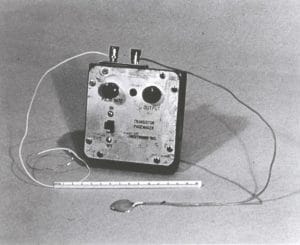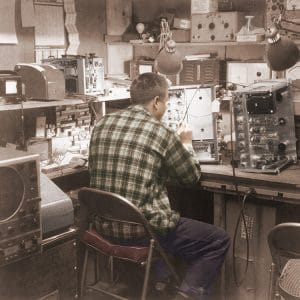An electrical engineer, Bakken’s interest in things electrical started when he saw the movie Frankenstein (the 1931 classic starring Boris Karloff) when he was 8 years old. “What intrigued me the most, as I sat through the movie again and again, was not the monster’s rampages,” he wrote in his 1999 autobiography, “but the creative spark of Dr. Frankenstein’s electricity. Through the power of his wildly flashing laboratory apparatus, the doctor restored life to the unliving.” In 1949, Bakken and his brother-in-law Palmer Hermundslie set up a small company in a Minneapolis, Minn., garage to repair hospital equipment. As hospitals and doctors began to trust Bakken, business grew, and the little company did well. On Halloween in 1957, a power blackout swept the city. One of the doctors Bakken knew was C. Walton Lillehei, a Department of Surgery professor at the University of Minnesota, who later became known as a pioneer in open-heart surgery. One of his patients had been on a pacemaker, which at the time was a giant machine that plugged into the wall; the power failure stopped the machine, and the patient — a child — died. He asked Bakken if he could come up with something that would work in a power failure.

Bakken went to work, starting with a circuit design he found for a transistorized metronome in Popular Electronics magazine. The company’s first employee (other than the founders), John Bravis, checked Bakken’s work and did the fabrication. Just four weeks later, the prototype was done. It had a dial to increase or decrease the heart rate, and another dial to set the power intensity. Bakken dropped off the prototype, assuming he’d get feedback before refining the design and making the device for use. But when Bakken returned the next day, he was shocked to see it was already in use on a patient — a little girl. Clearly it worked, and was the first portable battery-operated pacemaker. In 1958, another inventor came up with an implantable pacemaker. Bakken bought the rights to that device, improved it, and the company became a respected medical device manufacturer. “We almost went under in those first three or four years,” Bravis said in 2007. “I even loaned them money, about a thousand dollars at six percent interest. I think looking back now I would have said ‘keep the money I’ll take the stock!’”

Indeed the little company — Medtronic — became a big company. It’s now the world’s largest medical equipment manufacturer, employing 86,000 people. By 1961, it moved out of the garage into a new building. Bakken plowed his profits into philanthropy, including founding the Bakken Museum to showcase the history of electricity (going back to the year 1200!) Meanwhile, he needed a pacemaker himself — and, of course, got a Medtronic model; since it was continuously improved, that was replaced with another Medtronic model. “So I’m glad I invented the company,” he said later, “or I wouldn’t be sitting here.” Bakken ran Medtronic for 40 years, retiring as Chairman in 1989, and then from the company’s Board in 1994, but the company still runs by the mission statement he wrote in 1960. He died at his retirement home in Hawaii on October 21, at 94.
